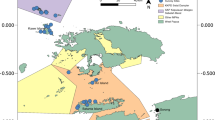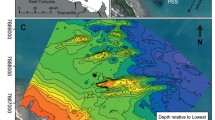Abstract
The amount of artificial habitat (termed ‘artificial reef’, AR) in marine systems is rapidly increasing, yet the effect of most types of AR on reef communities remains unknown. We examined the role of well-established vessel-reefs in structuring coral reef fish assemblages by comparing assemblages on 7 World War II wrecks (>65 years old) to those on interspersed coral patch reefs of comparable size in a tropical lagoon. Fish abundance, species richness, diversity and feeding guild structure on wrecks were similar to natural reefs; however, species composition differed between the two reef types (R = 0.189–0.341, average dissimilarity: 67.3–68.8 %). Despite being more species-rich and diverse, fish assemblages on larger wrecks were less similar to assemblages on their adjacent natural reefs than smaller wrecks. Wrecks may also have affected fish abundance on adjacent natural reefs, with reefs adjacent to larger wrecks supporting higher abundances than reefs adjacent to smaller wrecks. Our results indicate that increases in vessel-reef habitat may not greatly affect reef fish assemblage parameters, but may affect the relative abundances of particular species.




Similar content being viewed by others
References
Arena PT, Jordan LKB, Spieler RE (2007) Fish assemblages on sunken vessels and natural reefs in southeast Florida, USA. Hydrobiologia 580:157–171
Bellwood DR, Hoey AS, Choat JH (2003) Limited functional redundancy in high diversity systems: resilience and ecosystem function on coral reefs. Ecol Lett 6:281–285
Bellwood DR, Hughes TP, Folke C, Nystro M (2004) Confronting the coral reef crisis. Nature 429:827–833
Bohnsack JA (1989) Are high densities of fishes at artificial reefs the result of habitat limitation or behavioral preference? Bull Mar Sci 44:631–645
Bohnsack JA, Harper DE, McClellan DB, Hulsbeck M (1994) Effects of reef size on colonization and assemblage structure of fishes at artificial reefs off southeastern Florida, USA. Bull Mar Sci 55:796–823
Burt J, Bartholomew A, Usseglio P, Bauman A, Sale PF (2009) Are artificial reefs surrogates of natural habitats for corals and fish in Dubai, United Arab Emirates? Coral Reefs 28:663–675
Carr MH, Hixon MA (1997) Artificial reefs: the importance of comparisons with natural reefs. Fisheries 22:28–33
Chapman MG (2003) Paucity of mobile species on constructed seawalls: effects of urbanization on biodiversity. Mar Ecol Prog Ser 264:21–29
Chittaro PM (2002) Species-area relationships for coral reef fish assemblages of St. Croix, US Virgin Islands. Mar Ecol Prog Ser 233:253–261
Clark S, Edwards AJ (1994) Use of artificial reef structures to rehabilitate reef flats degraded by coral mining in the Maldives. Bull Mar Sci 55:724–744
Clark S, Edwards AJ (1999) An evaluation of artificial reef structures as tools for marine habitat rehabilitation in the Maldives. Aquatic Conserv Mar Freshwater Ecosyst 9:5–21
Clarke K, Warwick R (2001) Changes in marine communities: an approach to statistical analysis and interpretation. PRIMER-E Ltd., Plymouth
Diamant A, Ben Tuvia A, Baranes A, Golani D (1986) An analysis of rocky coastal eastern mediterranean fish assemblages and a comparison with an adjacent small artificial reef. J Exp Mar Biol Ecol 97:269–285
Emery B, Washburn L, Love MS, Nishimoto MM, Ohlmann JC (2006) Do oil and gas platforms off California reduce recruitment of bocaccio (Sebastes paucispinis) to natural habitat? An analysis based on trajectories derived from high-frequency radar Fishery Bulletin 104:391–400
Froese R, Pauly D (2011) FishBase. http://www.fishbase.org/. Accessed June 2011
Gardner TA, Côté IM, Gill JA, Grant A, Watkinson AR (2003) Long-term region-wide declines in Caribbean corals. Science 301:958–960
Gladfelter WB, Ogden JC, Gladfelter EH (1980) Similarity and diversity among coral reef fish communities: a comparison between tropical western Atlantic (Virgin Islands) and tropical central Pacific (Marshall Islands) patch reefs. Ecology 61:1156–1168
Grime JP (1997) Biodiversity and ecosystem function: the debate deepens. Science 277:1260–1261
Hixon MA, Beets JP (1993) Predation, prey refuges, and the structure of coral-reef fish assemblages. Ecol Monogr 63:77–101
Honório PPF, Ramos RTC, Feitoza BM (2010) Composition and structure of reef fish communities in Paraíba State, north-eastern Brazil. J Fish Biol 77:907–926
Hughes TP (1994) Catastrophes, phase shifts, and large-scale degradation of a Caribbean coral reef. Science 265:1547–1551
Jan R, Liu Y, Chen C, Wang M, Song G, Lin H, Shao K (2003) Effects of pile size of artificial reefs on the standing stocks of fishes. Fish Res 63:327–337
Jones RS, Thompson MJ (1978) Comparison of Florida reef fish assemblages using a rapid visual technique. Bull Mar Sci 28:159–172
Jordan LKB, Gilliam DS, Spieler RE (2005) Reef fish assemblage structure affected by small-scale spacing and size variations of artificial patch reefs. J Exp Mar Biol Ecol 326:170–186
Masuda R, Kai Y, Shiba M, Nakanishi A, Yamashita Y, Torikoshi M, Ueno M, Tanaka M (2010) Fish assemblages associated with three types of artificial reefs: density of assemblages and possible impacts on adjacent fish abundance. Fish Bull 108:162–173
Matthews KR (1985) Species similarity and movement of fishes on natural and artificial reefs in Monterey Bay, California. Bull Mar Sci 37:252–270
Mora C, Aburto-Oropeza O, Ayala Bocos A, Ayotte PM, Banks S, Bauman AG, Beger M, Bessudo S, Booth DJ, Brokovich E, Brooks A, Chabanet P, Cinner JE, Cortés J, Cruz-Motta JJ, Cupul Magaña A, Demartini EE, Edgar GJ, Feary DA, Ferse SC, Friedlander AM, Gaston KJ, Gough C, Graham NA, Green A, Guzman H, Hardt M, Kulbicki M, Letourneur Y, López Pérez A, Loreau M, Loya Y, Martinez C, Mascareñas-Osorio I, Morove T, Nadon MO, Nakamura Y, Paredes G, Polunin NV, Pratchett MS, Reyes Bonilla H, Rivera F, Sala E, Sandin SA, Soler G, Stuart-Smith R, Tessier E, Tittensor DP, Tupper M, Usseglio P, Vigliola L, Wantiez L, Williams I, Wilson SK, Zapata FA (2011) Global human footprint on the linkage between biodiversity and ecosystem functioning in reef fishes. PLoS Biol 9:e1000606
Murray JD, Betz CJ (1994) User views of artificial reef management in the southeastern US. Bull Mar Sci 55:970–981
Myers RF (1989) Micronesian reef fishes: a practical guide to the identification of the coral reef fishes of the tropical central and western Pacific. Coral Graphics, Guam
Pandolfi JM, Bradbury RH, Sala E, Hughes TP, Bjorndal KA, Cooke R, McArdle D, McClenachan L, Newman MJH, Paredes G, Warner RR, Jackson JBC (2003) Global trajectories of the long-term decline of coral reef ecosystems. Science 301:955–958
Perkol-Finkel S, Benayahu Y (2004) Community structure of stony and soft corals on vertical unplanned artificial reefs in Eilat (Red Sea): comparison to natural reefs. Coral Reefs 23:195–205
Perkol-Finkel S, Shashar N, Benayahu Y (2006) Can artificial reefs mimic natural reef communities? The roles of structural features and age. Mar Environ Res 61:121–135
Randall JE, Allen GR, Steene RC (1997) Fishes of the Great Barrier Reef and Coral Sea. University of Hawaii Press, Honolulu
Relini G, Relini M, Torchia G, Palandri G (2002) Ten years of censuses of fish fauna on the Loano artificial reef. ICES J Mar Sci 59:S132–S137
Rilov G, Benayahu Y (2000) Fish assemblage on natural versus vertical artifcial reefs: the rehabilitation perspective. Mar Biol 136:931–942
Rooker JR, Dokken QR, Pattengill CV, Holt GJ (1997) Fish assemblages on artificial and natural reefs in the Flower Garden Banks National Marine Sanctuary, USA. Coral Reefs 16:83–92
Shulman MJ (1984) Resource limitation and recruitment patterns in a coral reef fish assemblage. J Exp Mar Biol Ecol 74:85–109
Stone RB, Pratt HL, Parker RO, Davis GE (1979) A comparison of fish populations on an artificial and natural reef in the Florida Keys. Mar Fish Rev 41:1–11
Syms C, Jones GP (2000) Disturbance, habitat structure, and the dynamics of a coral-reef fish community. Ecology 81:2714–2729
Thanner SE, McIntosh TL, Blair SM (2006) Development of benthic and fish assemblages on artificial reef materials compared to adjacent natural reef assemblages in Miami-Dade County, Florida. Bull Mar Sci 78:57–70
Wilkinson C (2004) Status of Coral Reefs of the World. Australian Institute of Marine Science, Townsville
Acknowledgments
We thank J. McKinnon, J. Raupp and the staff and students from the 2010 Flinders University Maritime Archaeology Field School for access to wrecks and sampling assistance. We thank D. Feary, P. Macreadie, and members of the Fish Ecology Laboratory, UTS, for helpful comments on previous versions of the manuscript.
Author information
Authors and Affiliations
Corresponding author
Additional information
Communicated by D. Goulet.
Rights and permissions
About this article
Cite this article
Fowler, A.M., Booth, D.J. How well do sunken vessels approximate fish assemblages on coral reefs? Conservation implications of vessel-reef deployments. Mar Biol 159, 2787–2796 (2012). https://doi.org/10.1007/s00227-012-2039-x
Received:
Accepted:
Published:
Issue Date:
DOI: https://doi.org/10.1007/s00227-012-2039-x




